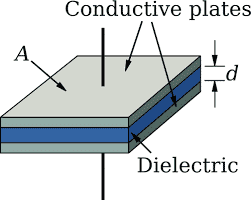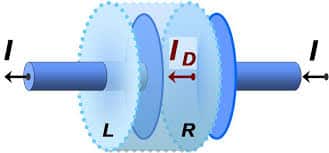In the field of electromagnetism, let us assume that the electric displacement field is given by D. The electric field can be observed across a conductor, or in a vacuum space. Vacuum in the sense if they assume that we have connected a capacitor, then the gap between the plates is assumed as a vacuum. After some time, once the capacitor is charged, even if we remove the source, there exists some amount of electric field across the plates of the capacitor. This is basically due to the property of the capacitor which says that the capacitor can store energy in the electric field, and the capacitor will not allow any change in the voltage. So an electric displacement field is created between the plates of the capacitor.
What is Displacement Current?
The displacement current is defined as the current due to a change in displacement current density. Conventionally, conduction current is said to be the current due to the flow of charges from one point to another when a potential difference or voltage is applied. The direction of this current flows from the positive terminal to the negative terminal. And the flow of charges is defined as current. As per Faraday’s law of electromagnetic induction, whenever a current flows it creates a magnetic field around it. The direction of the magnetic field is given by Lenz’s law in the case of the alternating voltage source. And the same current when flows, creates a magnetic field across the conductor. The direction of the magnetic field can be given by the right-hand thumb rule. This is called electromagnetism.

Displacement Current
Formula and Derivation
Displacement current formula and derivation can be defined as the rate of change of electric field displacement. That is dD/dt. In order to write the formulae for displacement current let us define first the electric field displacement
![]() Where D is the electric field displacement. ɛ is the permittivity of free space. E is the electric field intensity and P is the polarization of the medium. To obtain this current, the above equation is differentiated with respect to time, which gives the expression,
Where D is the electric field displacement. ɛ is the permittivity of free space. E is the electric field intensity and P is the polarization of the medium. To obtain this current, the above equation is differentiated with respect to time, which gives the expression,

The above equation has two parts in a dielectric. The first term on the right-hand side represents the material medium. It is associated with the magnetic field. It is equivalent to the conduction current that is caused due to the flow of charges. This current is caused to the relative change in the displacement current. . The second term indicates polarization current density, which implies the change in polarization of the individual molecules. The polarization is often caused due to the application of an electric field across a material. This can be extracted from the above equation by integration as shown below

The unit of displacement current is discussed below.
As the displacement current phenomenon is similar to conduction current. The unit of displacement current is the same as the conduction current. like amperes. The fundamental difference is conduction current is formed due to the flow of charges, and this current is formed due to the rate of change of electric current density. However, both the currents form a magnetic field whose direction can be found using the Fleming rule.
Dimension
Since the phenomenon of this current is the same as that of conduction current, the dimension of displacement current is also equal to conduction current which can be given as A.

Displacement Current
The Necessity of Displacement Current
As we have seen, the displacement current is caused fundamentally due to the rate of change of electric current density, the displacement current phenomenon can be observed in capacitors. We know that the capacitor has the property to store energy in the electric field, and the capacitor opposes the change in voltage. One more important property of the capacitor is, in the capacitor the current leads the voltage. It is the opposite of the case of an inductor, wherein the inductor, saves energy in the magnetic field and it opposes the change in current. An inductor, the current lags the voltage.
The leading nature of current in the capacitor is due to the displacement current. So the current leads to the voltage. This property has huge importance in electric applications. Because of the leading nature of current, the capacitor can improve the power factor which is one of the fundamental aspects of any electric load. Hence the displacement current is necessary for capacitors, as it makes the current leading and improves the power factor.
The significance of displacement current is, as we have seen that this current, caused the capacitor current to lead voltage. The important significance here is it improves the power factor. This property of the capacitor makes it enable to deliver reactive power wherever required. Because of this property, the capacitor can deliver reactive power and improve the power factor. It is often used as capacitor banks in substations or at industrial premises to improve the power factor. This current is the main reason behind it. Adding to conventional conduction current, the overall current leads to the voltage.
Displacement Current in the Capacitor
The displacement current is caused due to the rate of change of electric current density. This phenomenon is more important in capacitors. The capacitor is an element that is made up of two conducting plates and a dielectric medium in between. The dielectric medium can be paper, mica, or other insulating mediums. When a capacitor is charged, the energy is stored in electric fields. And based on the dielectric medium, the capacitance value is evaluated. Capacitance is also proportional to the dielectric medium and inversely proportional to the distance between the two conducting plates.

Displacement Current In Capacitor
When a capacitor is charged, with a helpful source of voltage, it starts building energy around it. At the same time, current also flows through the capacitor. This current is the conventional current and is caused due to the flow of charges. If we remove the source, then the conduction current becomes zero, and whatever the energy stored across the capacitor starts dissipating.
In that case, the current density across the capacitor starts reducing. The reduction of electric current density causes the displacement current and it can be defined as the rate of change of the displacement current. In the presence of potential differences also the current density starts building up. In this case, this current is of incrementing in nature. In this scenario, this current adds with the conduction current, and the overall current through the capacitor leads to the voltage. Because of this leading nature of current, the capacitor has the ability to improve power factors and deliver reactive power to the load.
Difference between Conduction Current and Displacement Current
The conduction current is formed due flow of charges. The flow of charges occurs, when we apply a potential difference. The conduction current when flows, causes an electric field across a conductor whose magnitude can be found out using Maxwell rules. Hence the conduction current causes a magnetic field. But in the case of displacement current, it is formed due to the rate of change of electric current density. In this case, the magnetic field caused across the plates of the capacitor, causes the conduction current to flow.
Properties
The properties of displacement current include the following.
- The properties of this current can be enumerated as
- This current is a vector quantity
- This is electric field per unit time
- The dimension of this current can be similar to the conduction current.
- The units of displacement current are the same as conduction current i.e. Amperes A
- It is caused due to the rate of change of electric current density
Hence we have seen an overview of the displacement current, its necessity, significance, and properties. It is interesting to note here that will there be any displacement current in inductors? If no, why?